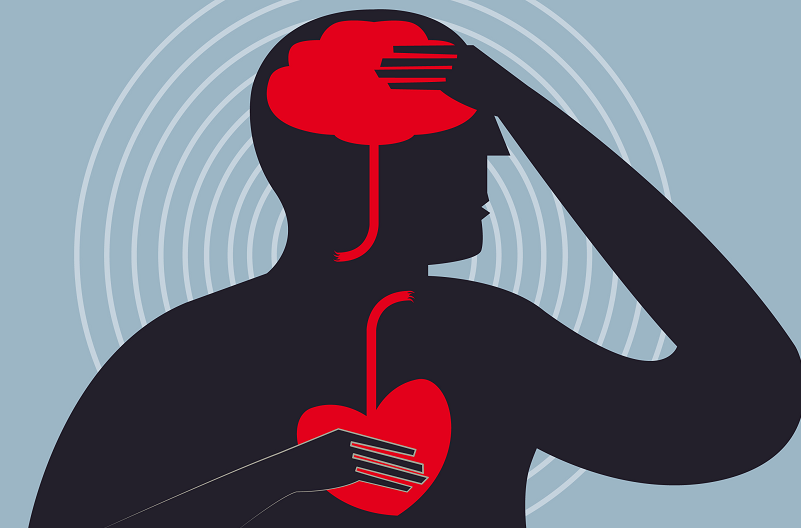Are Strokes and Heart Attacks the Same?

May 03, 2023
Strokes and heart attacks are both medical emergencies involving blood vessels. Are they different terms for the same thing, like “couch” and “sofa”? In short, no.
Strokes and heart attacks are very different conditions. Each has its own cause and symptoms, and each requires different treatments.
What happens when someone has a heart attack or stroke?
- Heart attack: Plaque can narrow the arteries leading to the heart, limiting or blocking blood flow. Without oxygen-rich blood, part of the heart muscle becomes damaged or dies.
- Stroke: Blood vessels supplying oxygen to the brain may develop blockages (or may rupture). Without access to oxygen-rich blood, areas of the brain become damaged or die.
“The location within the body is different, but the mechanism of action is comparable,” says Ghasan Ahmad, M.D., interventional neuroradiologist at Jersey Shore University Medical Center.
Not all strokes are caused by the same type of events.
Blood-vessel blockages cause ischemic strokes, the most common type of stroke. A ruptured blood vessel in the brain or aneurysm causes hemorrhagic strokes.
Similarities Between Strokes and Heart Attacks
Although strokes and heart attacks affect different organs, the process causing damage is similar. Perhaps because of this, strokes are sometimes called “brain attacks.”
Brain or heart damage may occur during strokes and heart attacks because of:
- Blood clots. They develop plaque that breaks free from arterial walls, blocking circulation to the heart. Sometimes, blood clots travel to the brain and block blood flow within the brain.
- Plaque. Fatty buildup known as plaque may stick to the inside of the arterial wall lumen throughout the body. Small pieces that become dislodged may block blood vessels in the brain or heart.
Both heart attacks and strokes are health emergencies and should be treated as such.
If you think that you’re having a stroke or heart attack, call 911 immediately. In both cases, getting prompt medical treatment may be life-saving or limit disability.
“Even if you’re unsure that it’s a heart attack or stroke, call 911,” says Matthew Saybolt, M.D., FACC, medical director of the Structural Heart Disease Program at Jersey Shore. “With these life-threatening conditions, it’s better to be safe than sorry.”
Differences Between Strokes and Heart Attacks
Heart attacks and strokes cause different life-threatening problems within the body. They also have different symptoms.
Common symptoms of stroke include:
- Paralysis or drooping on one side of the face
- Numbness on one side of the body (such as an arm or leg)
- Weakness on one side of the body
- Slurred speech
- Difficulty speaking or being understood
- Difficulty understanding what others are saying
- Loss of balance or coordination
- Confusion
- Dizziness
- Vision loss in one or both eyes
- Sudden, severe headache
Common symptoms of heart attack include:
- Chest pain that suddenly appears and remains constant or comes and goes
- Uncomfortable pressure on the chest
- Pain radiating down one or both arms
- Back or shoulder pain
- Jaw or neck pain
- Stomachache
- Shortness of breath
- Sweating
- Nausea and/or vomiting
- Indigestion
- Feeling lightheaded
- Fatigue
- A feeling of impending doom
Women are less likely to experience crushing chest pain during a heart attack. They’re more likely to have nausea, back pain and/or shortness of breath.
Risk Factors for Strokes and Heart Attacks
Some people are at increased risk of stroke and heart attack. They are more likely among:
- Men and those assigned male at birth
- Older adults
- People with a family history of stroke or heart attack
- Obese people
- People who are physically inactive
- Smokers
- People who consume too much alcohol
- People who are Black or Latinx
These health conditions increase the risk of both heart attack and stroke:
- High blood pressure
- Diabetes
- High cholesterol levels
- Obesity
How to Lower the Risk of Strokes and Heart Attacks
Simple lifestyle changes may reduce your risk of both heart attack and stroke:
- Eat a healthy diet, focusing on fruits, vegetables, beans, nuts, seeds and whole grains
- Choose lean protein (fish or beans) over red meat
- Opt for low-sodium foods
- Get at least 30 minutes of exercise daily
- Quit smoking, if you smoke
- Maintain a healthy weight, losing weight gradually, if necessary
“A nutritious diet coupled with regular exercise should lower stroke and heart attack risk,” Dr. Saybolt says. “Additionally, you may notice other positive health changes, like more energy or weight loss.”
Next Steps & Resources:
- Meet our sources: Ghasan Ahmad, M.D., Matthew Saybolt, M.D., FACC
- To make an appointment with a doctor near you, call 800-822-8905 or visit our website.
The material provided through HealthU is intended to be used as general information only and should not replace the advice of your physician. Always consult your physician for individual care.






